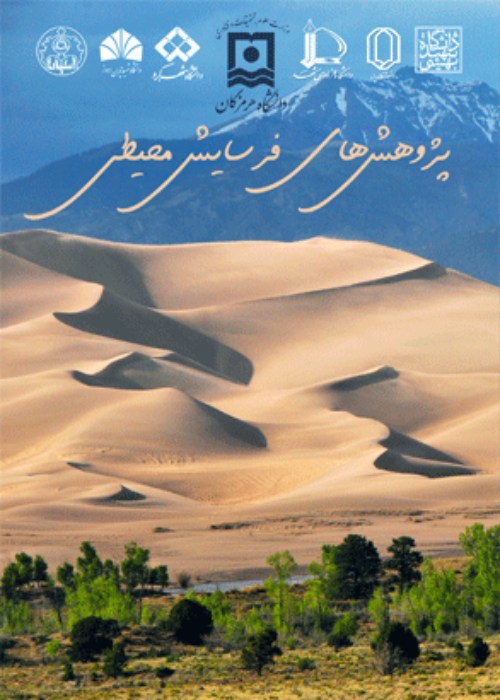Estimation of wind erosion threshold velocity using wind tunnel device in dust sources in Khuzestan, Iran (case study: Mahshahr, Omidiyeh, Hendijan)
Wind erosion is one of the destructive phenomena that cause environmental changes, changes in the quality of the weather threatens public health, and other economic and social issues in regions with dry and semi-dry climates. Using wind tunnels, the effect of wind velocity and soil properties, as well as the particle transport process, can be investigated under controlled conditions. Ries and Fister estimated the amount of wind erosion in the Ebro basin using a portable wind tunnel in 2009. To evaluate the rate of soil loss, three sample locations were assessed, and the results showed that the areas with unchanged ground surface had the lowest amount of wind erosion. The phenomenon of dust storms in Khuzestan province has had an increasing trend in terms of frequency and continuity in recent years. Considering the issue's importance, the present study was conducted to determine the threshold erosion velocity and erodibility of soils taken from the dust storm centers of Mahshahr, Omidiyeh, and Hendijan, using a wind erosion measurement device.
The dust centers of Mahshahr-Omidiyeh-Hendijan are located between 30°12'28" to 30°50'57" north latitude and 48°47'45" to 49°41'41" east longitude and have expanded between Mahshahr and Omidiyeh and Hendijan. Using the land unit map, maps from the Geological Survey Organization, and field studies, 32 points were identified in the Mahshahr, Omidiyeh, and Hendijan centers, representing various land units differentiated in the soil map. Finally, ten average points were selected. Samples taken from the soil surface inside the wind tunnel were tested. First wind thereshold velocity, Then the wind erosion rate was measured at speeds of 15, 20, 25, and 30 (m/s) for two minutes, and finally, the wind erosion rate of the sample points was obtained. The median diameter and mean diameter of the particles were determined using Gradistat software to determine the erodibility of the sample particles according to the Chepil theory (Table 2).
the amount of wind erosion increases at wind speeds of 15, 20, 25, and 30 (m/s) over two minutes. Under these conditions, higher wind speeds intensify soil loss and lead to an increase in the rate of wind erosion. The wind erosion threshold varies from 6 to 17 (m/s). The minimum wind threshold velocity is related to the Jarahi-Mahshahr sedimentary plain, which is sensitive to wind erosion at a threshold speed of 6 meters per second and the total amount of wind erosion rate of 12160 (gr/m2.min). The total amount of erosion rate ranged from 360 to 21860 (gr/m2.min) and the highest erosion rate was related to alluviums and alluvial cones in the shape of the Hendijan anticline. the erosion potential of soils taken from dust centers in Khuzestan province is high, and the dominant particle diameter of the soil is 0.5-0.15 (mm) and 0.05-0.1 (mm), which are susceptible to wind erosion. Therefore, all samples collected from dust centers in Khuzestan province are sensitive to wind erosion
Locating areas sensitive to wind erosion is one of the important solutions for stabilization. Given the importance of the issue, this study has focused on estimating the erosion potential and threshold velocity in the dust centers of Mahshahr, Omidiyeh, and Hendijan. The results of measuring the erosion rate using a wind tunnel device showed that the soil in these areas has a high erosion potential, and the erosion rate increases significantly with increasing wind speed. The minimum of the wind threshold velocity for sedimentary plains in jarahi-Mahshahr region, located in the northwest center, which indicates the high sensitivity of the soil in the area to wind erosion. The highest amount of wind erosion rate was related to alluvial fans and alluvial cone in the shape of the Hendijan anticlin. The fan-shaped alluviums deposited by the temporary rivers at the foot of the anticline mountains east of Hendijan, because the materials transported by the temporary rivers are mostly fine-grained and marls, so the amount of gravel in these alluviums is low and for this reason, the erosion susceptibility of these soils is very high and they should be stabilized in the early stages. These results are consistent with the results of Abbasi, which led to the preparation of a map of land sensitivity to wind erosion in this center. Studies related to particle size distribution showed the high sensitivity of the samples to wind erosion. Since the dominant diameter of all particles in the samples was in the range of 0.5-0.15 and 0.1-0.05 (mm), the potential for erosion susceptibility of all samples in the study area is high. However, in this theory, only one factor has been used to determine the potential for soil erosion and other effective parameters in erosion susceptibility have not been considered, so it is not possible to rely solely on this theory to estimate erosion.
- حق عضویت دریافتی صرف حمایت از نشریات عضو و نگهداری، تکمیل و توسعه مگیران میشود.
- پرداخت حق اشتراک و دانلود مقالات اجازه بازنشر آن در سایر رسانههای چاپی و دیجیتال را به کاربر نمیدهد.




